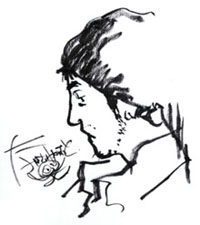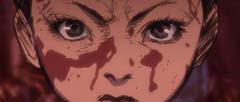The Making of Asience 5 part III: Kazuto Nakazawa (Director)
Kazuto Nakazawa did not just direct Asience: Hairy Tale. He was also responsible for character design, storyboards, animation directing and key art. The final result is a sixty-second concentrate of Nakazawa-esque themes and elements, and the film received great attention from international festivals throughout the globe. Nakazawa has been extensively involved with Production I.G's projects such as the animation segment in Kill Bill: Vol.1, the second opening sequence for the TV series Blood+, and the award-winning Kirin Lemon Black commercial. While focusing on Asience, we took this opportunity and asked Nakazawa the basics of creating anime by going over the works he directed in the past. This is the third of our exclusive 4-part interview with one of the most talented animators in the world scene.
 | Kazuto Nakazawa - Born in Niigata Prefecture on March 4, 1968. Animator. After graduating from the Tokyo Animator Gakuin, he joined studio Magic Bus, and later moved to studio Manglobe. His credits include Kill Bill: Vol. 1 (2003, animation sequence director), TV series Samurai Champloo (2004, character design, chief animation director), Linkin Park's video clip Breaking the Habit (2004 MTV VMA Viewer's Choice Award), the commercial film Kirin Lemon Black: Monster Blacks Fights Back (Best Commercial Film at the 11th Holland Animated Film Festival) and the episode Moondrive in Genius Party Beyond (2008). His latest collaboration with I.G is as character designer for the animated feature film Musashi: The Dream of the Last Samurai (2009), directed by Mizuho Nishikubo. |
part III
Talking of commercial films, you were the screen director for the Kirin Lemon Black commercial.
I relied completely on Katsuhito Ishii who was the director for this project. This came naturally, because I saw from his visual works that we shared many views. Ishii-san did the storyboards, so my work was like making a final copy of the storyboards. I was actually like an assistant by his side watching him do whatever he wished to do.
This work was awarded Best Commercial Film at the Holland Animation Film Festival.
I am grateful, but all I did was direct it. The artists were responsible for the background art and the characters were drawn by the inbetweeners and colored by the paint artists. The award was not meant for myself alone, but for the entire staff and we should all be celebrating. There is no place for arrogance in anime! (lol)

Even so, we notice you'd drawn quite a few cuts in the finished film.
Actually I never watch my finished work. (Watching into the monitor) Now that I take a look at it, I recall that I'd done some retouches here and there and also some key arts...
It seems like you placed emphasis on movement. Wasn't that hard to do?
I do remember people had a tough time. (lol) But basically, Production I.G is staffed with competent professionals, so it's a lot easier to work with them than with some other companies.
What are the things that you felt comfortable working with them on? For example, do they strictly keep to the schedule?
Or it's more like each department knew exactly what they had to do. And there are a lot of interesting people, starting from Ishikawa-san (1) and Mitsumoto-san (2). These two people have completely opposite characters and that surely makes them very interesting. I see that kind of magnetism in Production I.G.
Talking about your collaborating with Production I.G, none other than the animation part in Kill Bill: Vol. 1 comes to our mind right away. How did you decide to accept the job offer?
Initially, I.G's Ishikawa-san came to me, but I remember declining it.
You declined the offer initially?
Then I think Ishikawa-san took me out for dinner or something and it was difficult to say no. (lol) I consider those people who treat me are all nice people.

But it must have been an extremely difficult job.
The work I do is tough almost all the time, but I forget how tough things were in other respects.
You don't remember anything about how it was like in production?
Headache.
Headache?
Yup. I was at the I.G's studio and it was summer. What I remember is that my desk was under the air-conditioner, so it was freezing cold and I had the worst headache ever. I used to raise the thermostat, but before I knew it, someone would lower it again. I occasionally thought of tracking down the suspect.
Is there anything you were more particular about?
I made up my mind not to be awkwardly fashionable. I had this idea to add an alternative feel, because it was a Hollywood film by Quentin Tarantino. But at the end of the day, I felt even if I'd put a lot of thought to it, the overseas' audience might find it ordinary. So I decided to press forward with the Japanesque. It might sound rude, but the foreigners' images of Japan are in some parts comical. I thought they were expecting something similar in the animation. So I decided to create a style that's a little outdated and not cool. Anyways, I did my best in that direction.
You used broad lines like in Ashita no Joe (Joe of Tomorrow) and Kyojin no Hoshi (Star of the Giants) from the 1970's.
Exactly. I thought the overseas' audience might not have seen such lines in anime that were typical in our gekiga (graphic novel) tradition.
It must have been difficult to add motion to those broad lines.
I wasn't really aware of that in the beginning, but when I actually worked on it, it was hard. I have to thank the inbetween checker Yutaka Sakamoto. He did a really wonderful job helping me out.
You were the chief animation director as well. Didn't you draw any key art?
I did draw a few, but basically I was determined not to correct drawings that came to me. I might retouch close-ups, but I'd decided to use the original key art done by the key artists. Many of the old time anime shows were like that and those were the days when I was the most infatuated with watching anime, so I wanted to recreate that feel.
In Kill Bill: Vol.1, the touch of brush strokes presented a powerful image. Whereas the second opening of Blood+ has a more rigid and spectacular image.
Personally, I had this concept of a motionless opening sequence for that one. The music has a greater impact in the openings, so I thought the animation should not interfere with the sound. I don't mean the animation could ever be overwhelmed by the music, but when I animate great key art, you can tell they often lose the impact even if I do my best. That's a waste, so I thought an opening sequence that doesn't have noticeable movements - of course we didn't just connect still drawings - might be unique and nice. And I don't think anyone would want to do that, so I thought, why not? (lol)

Interestingly, the finished opening sequence doesn't give an impression that it's not moving. The peacock feathers and the portrayal of the natural surroundings took my breath away.
I wanted to use beautiful things from our daily lives. For the stone buildings, I processed with a technique called harmony and glued the original key art onto the background. I also used harmony for the peacock feathers and Hagi in the snow globe. If you look through a sphere, everything looks upside down. I thought this was interesting and experimented with it in the sequence. As for the character drawings, Kyoji Asano who was the chief animation director was very skillful and helped me a lot.
(1) Founder, President and CEO of Production I.G.
(2) Production I.G Chief Producer. He was with the studio since the early days.
(5/3 - to be continued)
© KIRIN LEMON BLACK
© 2003 Miramax Film Corp, All Rights Reserved.
© 2005 Production I.G · Aniplex · MBS · HAKUHODO

![WORK LIST[DETAILS]](/contents/works/design/images/left_title.gif)



 terms of use
terms of use